Hey, your occupation might not matter if you’re first in line with the cash…
by Wallace Wyss –
What if you were a postman and somebody offered you a tatty old racecar? You would think, well, that could be expensive to repair, but what the hell…you only live once, right? That’s the story of a Frenchman named Jacque Akexandre Lenglet, who bought a Ferrari GTO right before they hit it big with collectors.
First, a little bit about the Ferrari GTO. “Aerodynamics are for people who can’t build engines,” Enzo Ferrari is said to have been quoted. Compare a 250 GT SWB in profile with a Jaguar E-type. The E-type was streets ahead aerodynamically, since Malcolm Sayer, an aircraft designer, was instrumental in its shape. So Enzo assigned Giotto Bizzarrini, then in his employ, to design a more aerodynamic body for the GTO, one that could beat the E-type.
Bargains could have been had in the early 1960s on a GTO as shown by this ad below in Road & Track.
The GTO’s top speed is probably over 170mph. And, it turned out, Enzo worried needlessly; the E-type wasn’t that reliable in racing. The 250 GTO was one of the last racing Ferraris that could still be driven on the road. It is very rare; only 36 copies exist, and almost each one of them has a dramatic history.
How the Goat Came to Be
The car came about when, for the 1962 Manufacturer’s Championship, the factory’s attention switched from sports prototypes to GT cars. Ferrari built the 250 Gran Turismo Omologato (GTO), the last word meaning “homologated,” because Ferrari intended to slide it by as a mere variation of the existing short-wheelbase 250 GT, bypassing the need to make 100 of them, normally the rule for getting a car homologated in the GT class.
Since Ferrari had already built nearly 200 competition cars based on the 250 GT, the FIA approved the GTO homologation. The FIA would soon regret its decision.
Bizzarrini was given his own small team to develop the GTO, and dispensed with stylists. What the hell do you need them for? Instead, he took a mule and slapped on the Italian version of Bondo each night, then ran it on the Autostrada. The design with the fastest point-to-point time earned the car its needle-nose shape.
He also moved the V-12 engine more rearward and lower than in the 250 GT SWB, and installed a 4-speed. It was one of the first Ferrari road cars to have a “Kamm effect” rear end, the name referring to Dr. Wunibald Kamm, a German aerodynamicist who developed the theory that a chopped-off tail had good aero.
Notice the evolution of visual aerodynamics on Bizzarrini designed cars shown below: Ferrari 250 GTO, Ferrari 250 Breadvan, Bizzarrini GT 5300 Strada
No less an expert driver than Stirling Moss was hired to drive a GTO at Monza. Moss liked it so much he ordered one for himself, but was never able to collect it after he had a life threatening crash at Goodwood.
The First GTO
Ferrari had a press conference on February 24, 1962, rolling out the GTO and five other cars. It is believed the first GTO was chassis 3223GT.
The key to the GTO’s success was not only the shape, but the engine, tweaked over the version Bizzarrini had developed for the 250 GT SWB Competitzione. It had larger valves, tighter clearances, lighter materials, and dry sump lubrication. You could run it up to 9500 rpm. Basically, it was an outgrowth of the engine used in the 250 Testa Rossa.
The old 250 GT SWB chassis got new front brakes, Koni adjustable shock absorbers, a stiffer suspension, and a lower drive line.
Inside, the driver was not coddled. No heater. No soundproofing. No speedometer. Well, there was a Nardi wood-rimmed steering wheel, if you want luxury. The Borletti/Veglia tach read to 10,000 rpm and was jammed into a binnacle it shared with smaller diameter temperature, fuel, and oil-pressure gauges.
Other teams tried to protest against the GTO’s acceptance as a GT car but, if you read the rules, Appendix J, Section 254, said that any modifications introduced after homologation did not disqualify the car if those modifications were a “normal evolution of the type.” Since the GTO was an “evolution” of the largely produced 250 GT road car, it was declared legal, although the five-speed gearbox and dry sump lubrication were never factory road-car options. So Ferrari got away with it, laughing all the way to the bank.
However, when he came out with the mid-engined 250 LM later, the FIA punished him by not approving it as a GT car in its first year.
This is about GTO No. 4153.
Our car was first built in 1963 for Pierre Dumay, a Frenchman, but was actually campaigned by Ecurie Francochamps, in Belgium. They “cheated” the car a little by installing a 20-liter oil sump. She ran at Le Mans in ’63, finishing fourth overall. The biggest victory in period was in the Tour de France, where it finished first overall, with Lucien Bianchi and Georges Berger sharing driving tasks. In ’65, she finally got the Ecurie Francorchamps all-yellow paint job. In 1964, the car was in nearly a dozen events, as far as Angola, in Africa.
Barchettacc.com (a website with Ferrari histories) shows Pierre de Siebenthal sold it to a Spaniard, known only as E. Delgado, who owned it from 1966-70 and still ran the Italian original license plate, MO 84265.
The Postman Rings Once
The car was then bought by a postman, another Frenchman, Monsieur Lenglet of Romainville. Lenglet got it cheap because it was outmoded, the 250 LM having recently come out and all the hot-dog racers flocked over to the mid-engined car.
The price was approximately 2 million pesetas in Barcelona in the year 1970. This particular car was parked in a flimsy garage on Rosellon street in Barcelona. But when Lenglet tried to bring it to France, according to an account in CAVALLINO magazine, the French customs people harassed him to no end. “No yellow headlights,” they said. So he painted them translucent yellow. “The car is too low,” they said. And on and on. It was as if they were conspiring against an ordinary bloke owing one of the world’s greatest Ferraris.
So an embittered Lenglet kept the car in his garage for the next 16 years. Meanwhile, he suffered, driving a Simca. That’s like owning a Rolex but being forced to wear a Timex.
He finally began to worry it would get stolen as it increased in value. He sold it to Mr. Henri Chambon in 1986. Chambon raced it in the Tour de France two years in a row, then it went on to Swiss collector Nicolaus Springer.
In 1980 it went on to Bernd Grohe or Charles R. Grohe, of Germany, one of whom paid $6.5 million dollars. The last owner I could find a record of was Christian Glaesel, in Germany who is taking it to every Ferrari classic event worth going to.
When yours truly was writing a barn find book, I made inquiries as to the postman. Fortunately for him, I guess, I didn’t find out any more than his last name, because forevermore, if he was still with us, he might be reminded again by his car-loving friends of the 250 GTO he sold for a song.
Below is a photo of a Ferrari 250 GTO being used as a daily driver around 1970.
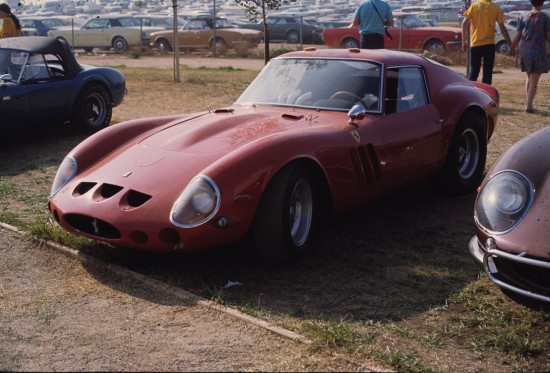
Ferrari 250 GTO in the parking lot of the Riverside Race Track, 1970, then owned by Stephen Mitchell-photo by Larry Crane
Lesson learned? It’s a key one for barn finders. It is this–you never know what happens to once prominent cars. It behooves you to start an action file on various cars that float your boat, no matter how far-fetched it seems right now that you will ever get a chance to buy them. That’s because those who can afford to buy these cars when they are new often have short attention spans—sometimes they barely learn the shift pattern in the one they have before they are off to the latest, greatest model, leaving the old one in the driveway of the car dealer.
This postman was in the right place at the right time to buy one of the most desirable cars ever made. But he was never in a position to use the car. Thus, it slipped his grasp…I feel for him….
Let us know what you think in the Comments.
THE AUTHOR: Wallace Wyss has written 18 books on performance cars. Now he paints portraits of them. For a list of artwork write malibucarart@gmail.com

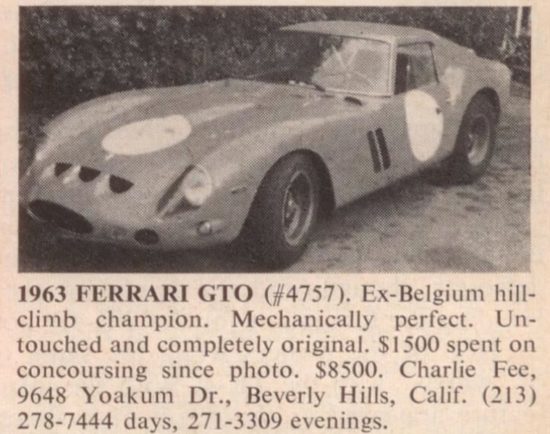
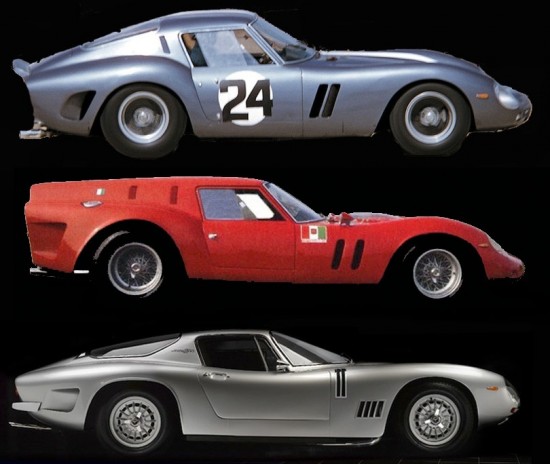


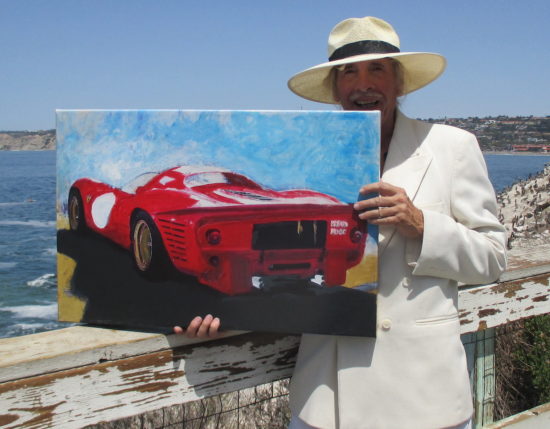
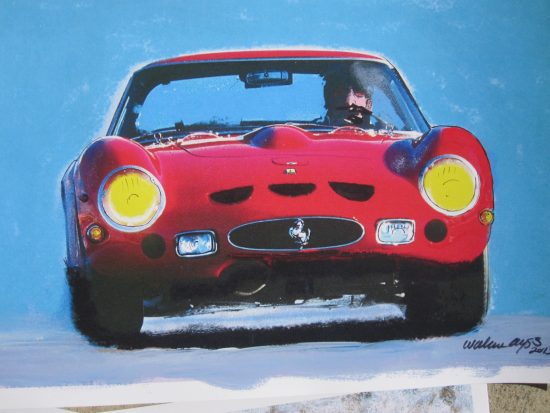


This is a very nice GTO article, Wallace. You sure give a valuable hint to those potential collectors out there too. Under the skin of of what looks like junk may lurk a historic marvel. And perhaps an equally historic market that inexplicably emerges. Besides, just swanning around in one of these old buggies can be a major point of pride.
Thanks also for plugging our book about my GTO 3223 GT. Having and racing that car was worth every drop of sweat, every tear, and every exhilarating triumph. “So, Larry, why did you sell it for peanuts?” they ask. Well, two reasons: it was a four-year-old wore-out race car, and $3,600 was the now-equivalent of about $30 K, not exactly pocket change back then.
So may your readers keep their eyes open for those barn-finds, and who knows? You may get an amazing letter from somebody one of these days!
I like your excellent straight-on painting of the car too. It nicely shows the image every XKE and DB4 driver in-period learned to hate seeing in their mirrors!
Larry
I have a theory about finding bargain classics on islands, inspired by a British barn finder who told me he “cleaned out Madagascar.” If somene can give me more islands where four wheeled goodies were found, I’ll write a column
Having recently done a bit of research into Giotto Bizzarrini related to a 1968 Bizzarrini 5300GT Strada on exhibit at The Savoy Auto Museum in Cartersville, Georgia, where I spend way too much time, this was a great read that tied together so many different aspects of what I run across whenever learning more about the background and history of the cars that pass through the museum, about 204 in just the last year. It was an excellent balance of history regarding the car’s development, evolution and ‘after life’ and a glimpse into the by-gone era of auto enthusiasts who happened upon cars at a time when car collecting had not yet evolved into the world of ‘fine art collection’ where the entry fee is now prohibitively expensive to those who were not ‘first on the beach’ either by chance like your average working man French postal carrier, men and women who were ‘insiders’ working regular jobs at the now iconic automobile manufacturers like Porsche, Ferrari and elsewhere who came to own the ‘cast-off’ development, pre-production house and factory racing stable cars, or entrepreneurs who started small auto dealerships, repair shops or junk yards and parts businesses who also came into possession of wrecks and cast-offs and those with a nose for finding diamonds under dust in barns.
Hey Mark:
When I hear about a new sighting of a Bizzarrini i’m like a marine biologist told of a new sighting of a pinch-nose whale (I made that species up) I hope you can tell us what you have learned, such as the SN , the owner history of the car, who restored it, and send pixtures to MCQ of interior and engine we can show along with the car’s history.. Technically the part I am most curuous about is how many 250GTO tricks he used on the Strada and how many new aero innovations are on the Strada over the GTO.
I suspect you may already know about this one. It’s Chassis: 1A3*0291, originally owned by Hollywood stuntman Carey Loftin when it was finished in a pale yellow color. It was purchased at the March 2022 Amelia Island Auction for $775k by car collector Ron Green of Sandy Springs, GA for his private collection and loaned to the Savoy for the “Locally Owned” exhibit that began in January and ends this month. I’ve got some additional info & photos at my scrapbook blog entry, but I’m hesitant to include the URL as doing-so seems to send reply’s to never-never-land. 😉
I might have bought that car from Carey Loftin. It sounds funny but I don’t remember the color. The car was in his garage near Huntington Beach. A few decades ago I was at a party hosted by the IsoBitz club and his wife was graciously serving us all a nice lunch. I kept waiting for the grand finale where he would march us out to the garage and show us his cars. But nobody was waiting and the guests all left so I ambled up and said “Can I see your cars?” when he opened the garage there was this tatty dust covered car, the dashboard was a shambles,His wife had volunteered to sew it, probably unaware sewing leather is formidable. So it could have been yellow. Anyway I was a buyer for a New York City based group and when I told the group he was amenable to selling they sent me out a check for I think$60,000. When I had it towed away his wife was crying, because she saw it as the end of his movie career. I was on his side because as he told her “I’m over 80–the phone calls aren’t coming anymore.” I also bought a yellow one parked outside in the snow somewhere back East in a small town. The local bank manger couldn’t believe the local loser could have anything worth , I can’t remember, $30,000.
I will look up the museum car and see what the Register says. My register’s latest dated entry is 2014 so doubltess many cars have changed hands since then.
I will send you a story commending the museum for showing it, and hope you can add to it Can you send me you email address to malibucarart@gmail.com